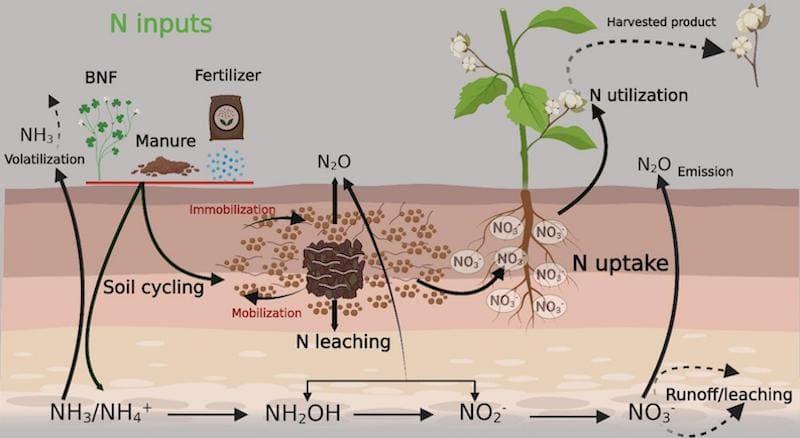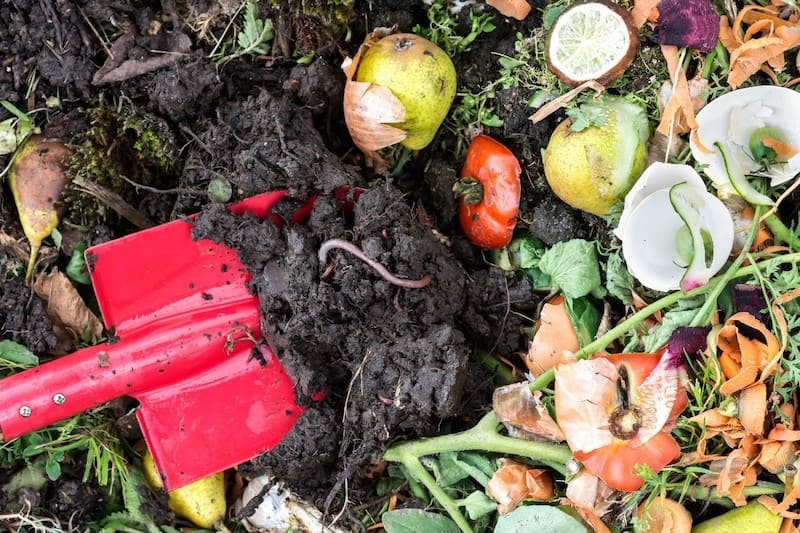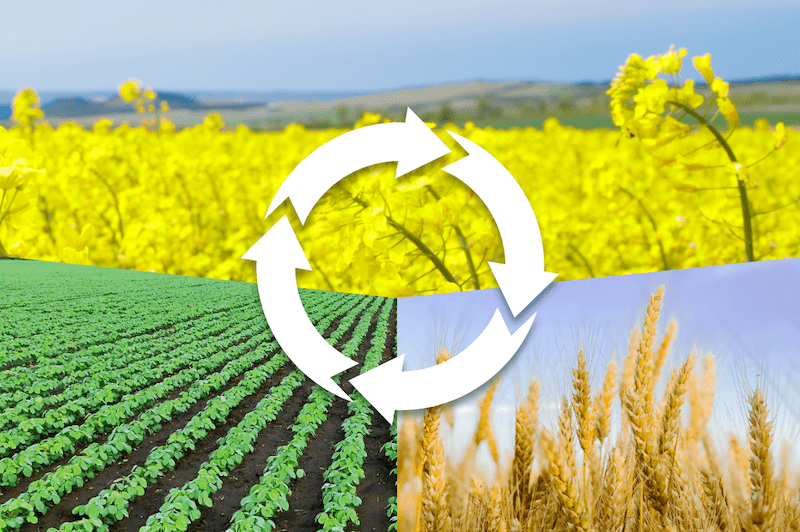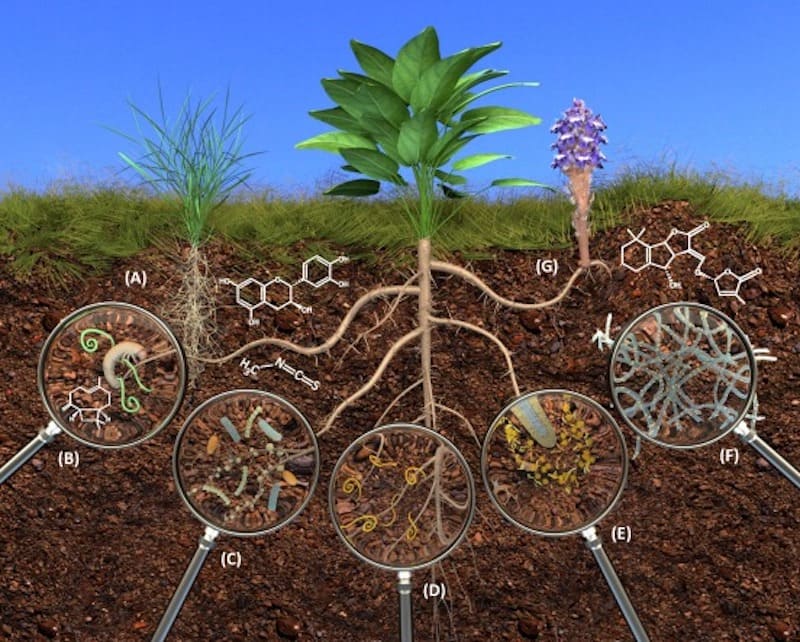
Welcome to the wonderful world of soil right under our feet! Today, we're gearing up to delve into the intriguing intricacies of nutrient management – an essential facet of our ongoing mission to advance sustainable agriculture.
Nutrient management is a nuanced discipline, referring to the crucial process of controlling and adjusting the amount and availability of essential nutrients in the soil. Our key objective is to promote plant well-being and productivity, whilst concurrently mitigating any possible harm to the natural environment.
Achieving successful nutrient management requires a meticulous understanding of nutrient cycling within the soil, which is a complex network of transformations and transfers of essential nutrients.
This understanding isn't complete without a firm grasp on the roles played by different organic and inorganic inputs in the cycle, and the myriad interactions between these elements. When we optimize nutrient management, we do more than just enhance the fertility of our soil or improve the yield of our crops. We essentially create a ripple effect, promoting overall ecosystem health.
As we embark on this captivating journey, we'll traverse the depths of numerous intricate processes that serve to maintain the delicate equilibrium of life beneath the surface of our Earth. From nutrient absorption and mineralization to nutrient leaching and denitrification, we will navigate through these interconnected phenomena that are paramount in effective soil and nutrient management.
Bear in mind, our soils' state is a reliable indicator of our planet's overall health. Therefore, our dedication to learning about and mastering nutrient management isn't just about boosting agricultural productivity, but it's an integral part of our collective responsibility towards the wellbeing of our Earth. Through understanding and implementing these principles, we contribute to a sustainable future, marking our respect for the interconnectedness of all life.

Often referred to as the keystone of nutrient management, the nutrient cycle is an elaborate natural phenomenon that ensures the unending flux of organic and inorganic materials, integral to the perpetuation of life. It effectively illustrates the dynamic movement and exchange of substances, beginning from their initial state as part of living organisms or environmental components, and their eventual reincorporation into the production of new living matter.
This cyclical process encompasses several critical stages, each linking to the next in a seamless, interconnected system. The journey begins with
The next stage involves the absorption of these released nutrients by plants. Through the remarkable process of nutrient uptake, plants use their root systems to take in these nutrients from the soil, enabling their growth and development.
TThese nutrients, now integrated into the plants, enter the next stage of the cycle when animals consume the plants. As these animals assimilate the nutrients, they become part of the complex web of life, illustrating the incredible journey of nutrients within our ecosystems.
Fertilizers act as pivotal tools in the domain of nutrient management. They serve a critical function in restoring soil nutrients, which have been consumed by plants during their growth and developmental stages.
Without the strategic use of fertilizer, the soil may experience nutrient exhaustion, a state that can gravely impact plant health and significantly reduce crop yields. Therefore, fertilizers play a crucial role in maintaining the soil's nutrient balance, ensuring continuous productivity and vitality.
These essential soil supplements can be divided into two primary categories: organic and inorganic. Organic fertilizers, such as compost or manure, derive from natural sources and are decomposed by soil microorganisms, releasing nutrients slowly over time.
On the other hand, inorganic fertilizers are typically commercially manufactured products, containing specific nutrient formulations that can be readily absorbed by plants. The choice of fertilizer type and the precise quantity to be applied hinge on the particular nutrient requirements of the soil and the plant species being cultivated.
This approach ensures targeted nutrient supplementation, tailored to optimize plant growth and productivity.
Despite the indispensable role of fertilizers, their application calls for careful consideration and responsible management. Overuse of fertilizers can trigger nutrient runoff, a scenario where excess nutrients leach into water bodies, thereby posing severe threats to aquatic ecosystems. This highlights the importance of comprehending nutrient cycling and understanding the nutrient profile of the soil. By integrating this knowledge, we can use fertilizers more effectively and responsibly, ensuring the wellbeing of our soil and the broader ecosystem.

Composting represents a natural, efficient strategy for managing soil nutrients, functioning as an excellent organic approach to enriching the soil. This practice involves the carefully managed decomposition of organic materials, such as vegetable peelings, fallen leaves, or grass cuttings, transforming them into a nutrient-dense soil amendment.
This organic matter decomposes through the action of various microorganisms, leading to the creation of compost, a valuable substance for enhancing soil fertility. Incorporating compost into the soil reaps multiple benefits. It enhances the soil's texture, which promotes plant growth by increasing its porosity, subsequently elevating its ability to absorb and retain water and vital nutrients.
Compost also fosters the proliferation of beneficial soil microorganisms, these tiny creatures playing a significant role in nutrient cycling and enhancing soil health. Furthermore, composting represents an environmentally friendly means of recycling organic waste. It diminishes the reliance on chemical fertilizers, thereby contributing to more sustainable agricultural practices.
Despite the apparent simplicity of composting, effective execution of this process calls for a well-balanced mix of green and brown materials. Green materials are rich in nitrogen and include kitchen scraps like fruit and vegetable peelings, while brown materials, high in carbon, comprise items such as dried leaves or twigs.
Along with these, adequate moisture and aeration are crucial for promoting the decomposition process, aiding in the creation of high-quality compost. Therefore, mastering the art of composting requires an understanding of these components and their roles in this organic recycling process.
Now, let's delve deeper into the cycles of three vital nutrients: nitrogen, phosphorus, and potassium. These elements are essential for plant growth and are commonly found in fertilizers.
The nitrogen cycle describes the mechanism through which nitrogen undergoes transformation into different chemical forms, circulating between the atmosphere, land, and oceanic ecosystems. Key processes include nitrogen fixation, nitrification, and denitrification.
The phosphorus cycle describes the movement of phosphorus through the lithosphere, hydrosphere, and biosphere. Unlike nitrogen, phosphorus cannot be obtained from the atmosphere and is primarily sourced from rocks and the waste products of plants and animals.
In the potassium cycle, plant roots extract potassium ions from the soil, assimilate these ions into plant tissues as organic compounds, and subsequently, through the decomposition of plant matter and animal waste, potassium is returned to the soil.
Understanding these cycles helps us manage these nutrients effectively and sustainably in our soils.
To gain a deeper understanding of nutrient management, we're going to explore the complex processes of three vital nutrient cycles: nitrogen, phosphorus, and potassium. These elements are fundamental for healthy plant growth, and consequently, they feature prominently in the formulation of fertilizers. Each nutrient follows a distinct cycle, playing an integral role in various biological and physical processes.
The nitrogen cycle serves as an illustrative model of the dynamic conversions and transfers of nitrogen across diverse ecosystems, ranging from the atmosphere to terrestrial and marine systems. This intricate cycle includes several key processes.
Firstly, nitrogen fixation, wherein atmospheric nitrogen (N2) is converted into a form usable by plants, primarily by symbiotic bacteria in legumes or by lightning. Following is nitrification, a two-phase procedure in which ammonia (NH3) is initially converted into nitrite ions (NO2-), which then change into nitrate ions (NO3-), a form easily absorbed by plants.
Finally, denitrification wraps up the cycle, a process where nitrate ions are converted back into gaseous nitrogen by bacteria, thereby returning it to the atmosphere.
Next in line is the phosphorus cycle, outlining the journey of phosphorus through the lithosphere, hydrosphere, and biosphere. In contrast to nitrogen, phosphorus can't be taken from the atmosphere; its primary acquisition is from rocks and minerals, achieved through weathering procedures and the decomposition of organic waste from plants and animals.
These phosphates are absorbed by plants, transferred to animals through consumption, and eventually returned to the soil through organic waste, completing the cycle.
Lastly, the potassium cycle pertains to the movement of potassium ions within the ecosystem. This cycle starts with plants absorbing potassium ions from the soil via their root systems. These ions are then integrated into various organic compounds within the plant. Once the plant or the consuming animal dies and decomposes, or when an animal excretes waste, potassium is returned to the soil, ready to be used again in the cycle.
Grasping the complexities of these nutrient cycles provides invaluable insights into how to manage these essential nutrients sustainably and effectively within our soils. Through this understanding, we can support plant health, bolster agricultural productivity, and contribute to the overall wellbeing of our ecosystems.

Crop rotation, a revered agricultural tradition, is a powerful method for bolstering soil fertility and promoting
By doing so, it safeguards against the exhaustion of essential nutrients, which could occur if the same crop was grown continuously. Moreover, implementing crop rotation can boost the presence of specific nutrients in the soil, leading to a more nutrient-dense environment.
Consider the example of legumes, such as peas or beans. These plants have a unique ability to fix atmospheric nitrogen due to their symbiotic relationship with Rhizobium bacteria housed in their root nodules. As these legumes grow, they enrich the soil with nitrogen, making this nutrient readily available for subsequent crops that demand high nitrogen levels, such as corn or wheat. By rotating legumes with these nitrogen-loving crops, farmers can naturally boost the nitrogen content of their soils.
Beyond its nutrient management benefits, crop rotation has several other advantageous implications for farming. It can serve as a natural deterrent for pests and diseases, reducing the need for chemical control methods.
It can also improve soil structure and foster greater biodiversity by supporting a range of different plant species and the associated fauna. Consequently, integrating crop rotation into farming practices is a cornerstone of efficient and sustainable nutrient management.
Through this approach, we can nurture healthier soils, enhance crop yields, and contribute to more resilient farming systems.
Organic matter and cover crops hold instrumental roles in curbing nutrient leaching, a phenomenon where water-soluble plant nutrients are lost from the soil. Nutrient leaching not only erodes the soil's nutrient profile, resulting in nutrient deficiencies, but it also jeopardizes groundwater quality due to the risk of contamination.
By managing organic matter effectively and employing cover crops, we can mitigate nutrient leaching and uphold soil fertility.
Organic matter, encompassing materials such as compost or decaying plant residues, serves as a valuable asset in improving soil health. By improving the soil structure, it boosts the soil's ability to hold water and nutrients, thereby aiding in the reduction of nutrient leaching. Moreover, organic matter facilitates nutrient cycling, a natural process that ensures the availability and balanced distribution of essential nutrients for plant growth.
Meanwhile, cover crops, which are grown for the purpose of soil conservation rather than harvest, act as another significant player in preventing nutrient leaching. They play a role in mitigating soil erosion, a primary factor in nutrient depletion, and assist in boosting the level of organic matter in the soil.
Moreover, cover crops can take in surplus nutrients that could otherwise be washed away through leaching. When these plants decompose or are integrated back into the soil, they release these absorbed nutrients, rendering them accessible for the next crop cycle.
Therefore, the strategic management of organic matter and the utilization of cover crops emerge as effective strategies to mitigate nutrient leaching and maintain soil fertility. These practices contribute to healthier soil, better crop yields, and overall, more sustainable agricultural systems. Recognizing and implementing such strategies will be crucial in our ongoing efforts to nourish the earth and sustain our food production systems.
Bioavailability is a crucial term in the realm of nutrient management, referring to the portion of nutrients present in the soil that plants can effectively absorb and utilize for their growth. One major element that profoundly affects the bioavailability of nutrients is soil pH, a metric that gauges the level of acidity or alkalinity in the soil.
The bioavailability of each nutrient is intricately tied to specific pH ranges. For instance, vital nutrients like nitrogen, phosphorus, and potassium exhibit maximum availability in slightly acidic to neutral soils, with a pH value between 6 and 7. Within this pH range, these nutrients can be readily taken up by plant roots, promoting healthy growth and development.
However, extreme pH values can disrupt this nutrient balance, potentially causing nutrient deficiencies or toxicities.
Take the example of iron, a key nutrient for plant growth. In alkaline or high pH soils, iron becomes less available, which could lead to iron deficiency in plants, inhibiting their growth. On the flip side, in extremely acidic or low pH soils, aluminum becomes more soluble and hence more available. While some aluminum is necessary for plant health, excessive amounts can prove toxic to plants, causing stunted growth and potentially leading to plant death.
Hence, maintaining the appropriate soil pH is paramount for the optimal availability of nutrients and overall plant health. Through regular soil testing and adjusting pH levels as necessary, farmers and gardeners can ensure they're providing an ideal environment for their plants, optimizing nutrient bioavailability, and promoting robust and productive growth. Recognizing the link between soil pH and nutrient bioavailability is an integral part of efficient nutrient management tactics.
Let's delve deeper into the intricate mechanics of nutrient cycling by focusing on three crucial processes: mineralization, nitrification, and denitrification. These biogeochemical changes, primarily directed by soil microorganisms, play a crucial part in enabling nutrients for plant utilization and preserving soil nutrient balance.
To start with, mineralization, where soil microorganisms convert organic matter like decomposing plants or animal waste into inorganic nutrients, is a key process.
This process is of prime importance in nutrient cycling since, for most nutrients, only the inorganic forms can be directly absorbed by plant roots. Thus, through mineralization, nutrients locked up in organic matter are released and transformed into a form that plants can effectively utilize for their growth and development.
Nitrification follows mineralization, serving as a two-step biochemical processthat transforms ammonia into nitrite and subsequently into nitrate. This transformation is facilitated by two distinct groups of bacteria – Nitrosomonas and Nitrobacter, respectively.
Nitrates, the final product of nitrification, are the most accessible form of nitrogen for most plant species. Thus, nitrification serves as a key stage in rendering nitrogen, an indispensable nutrient for plant development, available to plants.
Lastly, denitrification is a process that operates in reverse to nitrification. Under conditions with limited oxygen, certain bacteria transform nitrates back into nitrogen gas, which is then released into the atmosphere. Although this is a natural and necessary procedure in the global nitrogen cycle, it can also lead to the depletion of utilizable nitrogen from the soil.
Therefore, managing soil conditions to limit excessive denitrification is an essential aspect of effective nutrient management.
Through understanding and regulating these processes, farmers and garden enthusiasts can maximize nutrient availability in the soil, stimulate robust plant growth, and aid in fostering more eco-friendly agricultural methods. These intricate transformations underline the beautiful complexity of life beneath our feet, demonstrating how soil health and plant health are inextricably intertwined.

The rhizosphere, the narrow region of soil that is directly influenced by root secretions and associated soil microorganisms, acts as a vibrant hub of nutrient cycling processes. This zone, humming with microbial activity, is where plant roots and microorganisms engage in a dynamic interplay that significantly influences the availability and uptake of nutrients.
Plant roots exude various substances, known as exudates, into the rhizosphere. These exudates - comprised of sugars, amino acids, and other organic compounds - serve as a potent lure and sustenance for a diverse array of soil microorganisms.
This influx of microbial life enhances the rhizosphere's capacity to break down organic matter and convert nutrients into forms that are readily absorbed by the plants. By secreting these exudates, plants essentially cultivate their own beneficial microbial communities, which assist in making nutrients available for plant uptake.
Plus, certain microbes, including Rhizobium bacteria and mycorrhizal fungi, create beneficial symbiotic alliances with plants in the rhizosphere. Rhizobium bacteria, for example, can convert atmospheric nitrogen into a form plants can use – a process known as nitrogen fixation. However, mycorrhizal fungi stretch their network of hyphae (fungal filaments) into the soil, effectively amplifying the root surface area for nutrient assimilation.
These partnerships significantly enhance the plants' nutrient uptake capabilities, contributing to their overall health and productivity.
Therefore, the rhizosphere emerges as an indispensable protagonist in the narrative of nutrient management. It's a bustling marketplace of exchanges between roots and microorganisms, making nutrients more accessible and ensuring the health and prosperity of the plant community above ground. Understanding and nurturing this unseen world is a key aspect of sustainable agriculture and gardening practices.
Improper or poor nutrient management can lead to a detrimental environmental phenomenon known as nutrient runoff. This happens when surplus nutrients, added to the soil for crop development, get washed away by rainfall or irrigation water and end up in adjacent water bodies, like streams, rivers, lakes, and oceans. Nutrient runoff can pose significant environmental challenges, giving rise to a harmful process called eutrophication.
Eutrophication is essentially the ecological result of the incoming flow of plentiful nutrients, particularly nitrogen and phosphorus, into a body of water. This surplus of nutrients stimulates an explosive growth of algae, known as an algal bloom. While algae are a natural part of aquatic ecosystems, these sudden, dense growths can cause serious imbalances.
When these large volumes of algae eventually die and decompose through bacterial activity, it causes a significant reduction in the amount of dissolved oxygen in the water. This phenomenon of low oxygen, known as hypoxia, can lead to the formation of "dead zones" where the oxygen concentration is so scarce that most aquatic species cannot thrive. This could lead to a notable loss of biodiversity and disruption to the ecosystem's regular functions.
Consequently, effective nutrient management transcends the boundaries of maintaining soil fertility and bolstering crop yields; it extends into the realm of environmental stewardship. It's about the resourceful and sustainable use of resources, accompanied by a thorough awareness of the extensive consequences of our actions. By managing nutrients effectively, we can not only support productive agriculture but also safeguard the health and integrity of our waterways and broader environment.
Sustainable agriculture is a holistic approach, designed to meet our present food and fiber requirements while also ensuring that the needs of future generations aren't jeopardized. This approach integrates a multitude of practices that fortify soil health, optimize water usage, curtail pollution, and augment biodiversity, all towards creating a balanced and resilient agro-ecosystem.
Central to the concept of sustainable agriculture is nutrient management. When nutrients are managed astutely, we can enhance soil fertility, boost crop productivity, curtail the dependency on synthetic fertilizers, and mitigate potential environmental damage. Effectively, it forms the linchpin of a system that aspires to nourish the planet while minimizing environmental harm.
In the toolbox of sustainable agriculture are several practices like crop rotation, cover cropping, composting, and
Cover crops are planted to manage soil erosion, soil fertility, and biodiversity, not for harvest. Composting recycles organic waste into a rich soil enhancer, diverting it away from landfills. Organic farming eschews synthetic fertilizers and pesticides, promoting soil health through natural means.
Each of these practices contributes towards nutrient management, creating a fertile synergy that enhances the overall agricultural system's sustainability.
Consequently, adopting sustainable agriculture practices is a meaningful stride towards mastering nutrient management and shaping a more resilient and productive future.
Soil conservation comprises a range of practices aimed at preventing soil erosion, sustaining soil health, and amplifying its productive capacity. These practices are instrumental in preserving our vital soil resources and ensuring their long-term productivity. Furthermore, they are fundamental to successful nutrient management, underscoring their multi-faceted importance in sustainable agriculture.
Several soil conservation strategies double as effective tools for nutrient management. These include contour plowing, terracing, and the use of cover crops and buffer strips, among others. Contour plowing, where farming is done following the natural contours of the landscape, helps to slow water runoff, thus reducing soil erosion and nutrient loss.
Terracing involves shaping the land into a series of steps to slow down the flow of water, further preventing nutrient runoff. Cover crops protect the soil surface from erosion, improve soil structure, and add organic matter to the soil. Buffer strips, areas of land maintained in vegetation, help to intercept pollutants and sediment, minimizing nutrient leaching and preserving soil fertility.
In addition, these conservation strategies serve to bolster soil health and curtail erosion, which in turn safeguards the soil's ability to store and cycle nutrients. Healthier soils are more capable of retaining nutrients and providing a suitable environment for beneficial soil microorganisms that play a vital role in nutrient cycling.
Thus, the practices of soil conservation and nutrient management are intertwined, each contributing significantly to the resilience and productivity of our agricultural systems. In essence, a commitment to soil conservation is an investment in effective nutrient management, supporting the overarching goal of sustainable agriculture.

Agroecology presents a holistic approach to farming that embraces the entire ecosystem, viewing it as a dynamic interplay of components rather than isolated, individual elements. It champions the optimization of interactions among plants, soils, animals, and humans, aspiring to foster a more sustainable and resilient food system.
When applied to nutrient management, the agroecological perspective advocates for practices that augment nutrient cycling, mitigate nutrient losses, and sustain soil health. A core strategy includes diversifying crop systems, which enhances soil biodiversity, promotes more balanced nutrient utilization, and improves resilience against pests and diseases. The use of organic fertilizers, such as compost and manure, replaces essential nutrients that crops remove from the soil, doing so in a way that also improves soil structure and promotes beneficial soil life.
Another integral component of the agroecological approach is agroforestry, which integrates trees into farming systems. These trees help to cycle nutrients from deep within the soil profile, reduce erosion, and provide habitat for beneficial insects and birds.
Moreover, the agroecological approach underscores the importance of promoting biodiversity, both above and below the ground, as a way of maintaining a healthy and productive soil ecosystem.
The overarching philosophy of agroecology is one of alignment with nature, striving to work in concert with natural processes rather than attempting to dominate or suppress them. This means managing nutrients in a way that respects the delicate ecological balance, minimizes pollution, and enhances soil fertility over the long term.
It recognizes that by understanding and working with the laws of nature, we can achieve effective nutrient management while also safeguarding the health and sustainability of our ecosystems. In essence, agroecology provides a blueprint for a more sustainable, resilient, and equitable approach to farming.
Nutrient uptake represents a critical aspect of plant growth and development, wherein plants absorb essential nutrients from the soil through their extensive root systems. This process, integral to plant health and productivity, is enhanced by two biological interactions: nitrogen fixation and mycorrhizal associations, both of which embody symbiotic relationships between plants and microorganisms, improving nutrient availability and uptake.
Nitrogen fixation is a process uniquely performed by certain microorganisms, predominantly bacteria from the genus Rhizobium. These bacteria have the remarkable ability to convert atmospheric nitrogen, which is unusable to plants, into a usable form. In a mutually beneficial arrangement, these bacteria colonize the roots of leguminous plants, forming specialized structures called nodules.
Within these nodules, bacteria convert nitrogen from the air into ammonia, a form plants can readily use. Consequently, leguminous plants like peas, beans, and clover have a reliable source of nitrogen, one of the most crucial nutrients for plant growth.
On the other hand, mycorrhizal associations represent a partnership between certain types of fungi and plant roots. In this symbiotic relationship, the fungi attach themselves to plant roots, effectively extending the root system's reach and significantly enhancing the plant's ability to absorb water and nutrients, especially phosphorus, from the soil. In return, the fungi receive sugars, a source of energy produced by the plant during photosynthesis. By increasing nutrient uptake efficiency, mycorrhizal associations promote healthier, more resilient plants.
Together, nitrogen fixation and mycorrhizal associations showcase the complexity and elegance of natural systems, revealing the intricate symbiotic relationships that enhance nutrient availability and uptake. These processes are integral to nutrient management, helping to increase agricultural productivity sustainably, improve soil fertility, and contribute to a balanced soil ecosystem.
Nutrient recycling represents a practical and eco-friendly approach to managing and reusing waste materials as a source of nutrients. This dynamic process can be employed through several methods, such as composting household waste like fruit peels and vegetable scraps, recycling agricultural byproducts like crop residues, or utilizing animal waste as an organic fertilizer.
At its core, nutrient recycling serves dual purposes. Firstly, it effectively reduces the generation of waste, thereby contributing to a more sustainable environment. Secondly, it decreases the dependence on synthetic fertilizers, which can have adverse effects on soil health and the broader environment.
Furthermore, by transforming waste into valuable, nutrient-rich amendments, this process not only promotes a circular economy where waste is seen as a resource rather than a disposal problem, but it also enhances the fertility and structure of the soil.
The reintroduction of these waste-derived nutrients into the soil replenishes the soil's nutrient content, thereby contributing to the broader nutrient cycle. This ensures the continuous availability of essential nutrients that are indispensable for plant growth, promoting higher yields and healthier crops.
Above all, nutrient recycling aligns with the principles of sustainable agriculture and the circular economy, both of which emphasize the importance of minimizing waste and maximizing resource efficiency. It champions the concept that waste is not merely something to be discarded, but instead, a valuable resource that can be utilized to nourish our soils and sustain our agricultural systems.
This perspective makes nutrient recycling an environmentally friendly and sustainable approach to nutrient management, reinforcing our commitment to conserving resources and protecting our planet.

Buffer strips, commonly implemented along water bodies and surrounding agricultural fields, are valuable areas of land deliberately maintained in permanent vegetation. These carefully designated areas serve multiple ecological and agricultural purposes, designed specifically to intercept potential pollutants, manage water flow effectively, and mitigate soil erosion.
These strips act as guardians of our water resources and fields, strategically preventing nutrient runoff. They trap sediment and nutrients that could otherwise be carried away from agricultural fields during heavy rains or irrigation. The ability of buffer strips to halt these nutrients in their tracks means they don't end up contaminating nearby water bodies, thereby protecting aquatic life, and preserving water quality.
However, their role extends beyond merely trapping nutrients. As the trapped nutrients slowly decompose and break down, they contribute to nutrient cycling, converting these elements back into a form that can be utilized by plants. In this way, buffer strips help to maintain the delicate balance of nutrients within the soil, enhancing soil fertility and promoting healthier plant growth.
Buffer strips also serve as a habitat for a wide variety of species, thus encouraging biodiversity. They can host a plethora of organisms, from birds and insects to small mammals, creating a mini ecosystem that contributes to the overall health of our environment.
In addition to their ecological benefits, these strips have a significant role to play in nutrient management within farming practices. By reducing nutrient runoff, they help maintain a high level of soil fertility, necessary for optimal crop growth. Moreover, they assist in protecting the quality of our water resources, which are increasingly under threat from agricultural pollutants.
Buffer strips play a vital role in safeguarding our soil, our water, and our biodiversity. By understanding and leveraging their benefits, we can improve our nutrient management strategies, leading to more sustainable and environmentally friendly agricultural practices.
As we conclude our exploration of nutrient management, it's clear that this is a complex, multifaceted field that requires a deep understanding of the soil's biological and chemical processes.
The future of nutrient management lies in sustainable, eco-friendly practices that enhance nutrient cycling, reduce nutrient losses, and maintain soil health. Practices such as composting, crop rotation, and the use of cover crops and buffer strips will play a crucial role.
Moreover, advances in technology, such as precision agriculture, will allow us to manage nutrients more efficiently, tailoring management practices to the specific needs of each field.
By mastering nutrient management, we can contribute to a more sustainable and resilient food system.